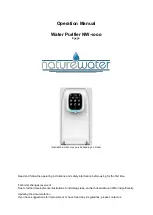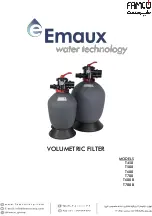
02/2017
www.vgebv.nl
9/18
Manual for:
VGE Pro UV Control 400/420/600 and VGE Pro UV Control 140/200
EP600001, EP200002
• The unit may only be wired according to the wiring diagram shown here.
• Do not add any components such as switches, capacitors or ignition devices to the wires between ballast and lamp
because this may damage the ballast.
• Make sure that all wires are sufficiently insulated with respect to each other and to earth.
• Wire gauge and length are specified according to connector manufacturers general data. Make sure that the actual
wire size complies with the current electrical specifications.
• The terminals are designed to clamp rigid and flexible wires without wire termination. If wire termination is used it must
comply with the appropriate terminal specification.
• Rigid wiring:
- may be inserted directly into the terminals without pressing the release lever if specified wire gauge is used
• Flexible wiring (braid wires):
- may only be inserted direct into the terminals by pressing the release lever on the terminal
- may not be soldered/tinned (This applies especially to screw terminals. The solder migrates into the contact,
resulting in less reliable connection.)
- wire end ferrules may be used, although not necessary
• Make sure that the terminals are properly connected.
• Check wiring for secure connection. This is advisable especially after mechanical stress such as transportation.
To check the wiring at the terminal try to pull out the cable gently; the terminal should not allow the wire to move.
RS485 communication cable routing
• Use twisted pair (shielded) cable for communication wiring, connect shield to the central earth point.
• Do not cross RS485 communication cables and mains or lamp cables. If this is unavoidable, cross the cables at right
angles as far apart as possible in order to reduce high frequency coupling.
• Do not route RS485 communication cables and mains or lamp cables parallel or close to each other.
Keep them as far apart as possible from each other (minimum: 5-10 cm) to avoid radio interference between leads.
Lamp/Mains cable routing
• Do not cross mains and lamp cables. If this is unavoidable, cross the cables at right angles as far apart as possible in
order to reduce high frequency coupling.
• Do not route mains cables and lamp cables parallel or close to each other.
Keep them as far apart as possible from each other (minimum: 5-10 cm) to avoid radio interference between mains
and lamps leads.
• Route a separate wire with size of 4mm² that is connected to earth in parallel to the lamp wires to reduce radiated
emissions at lamp wires. Do not use multi-core cables with integrated protective earth wires.
• Use one cable per lamp.
Lamp/Mains cable length
• Keep mains cable short to reduce radio interference.
• Keep the lamp cables as short as possible to reduce electromagnetic interferences and to minimise parasitic
capacitances.
• When considering the max. lamp cable length, all cables inside the cabinet and inside the reactor/channel must be
included.
• Selection of cable types and layout should be made with respect to the lowest coupling capacity and inductance.




































